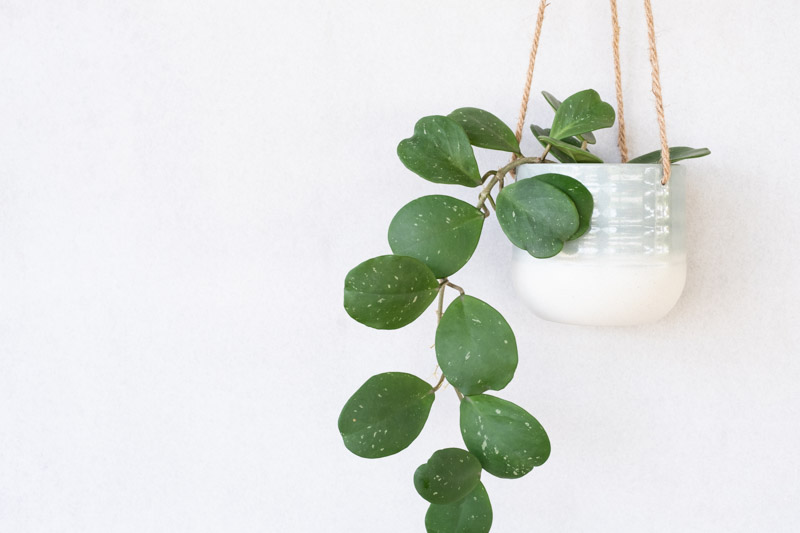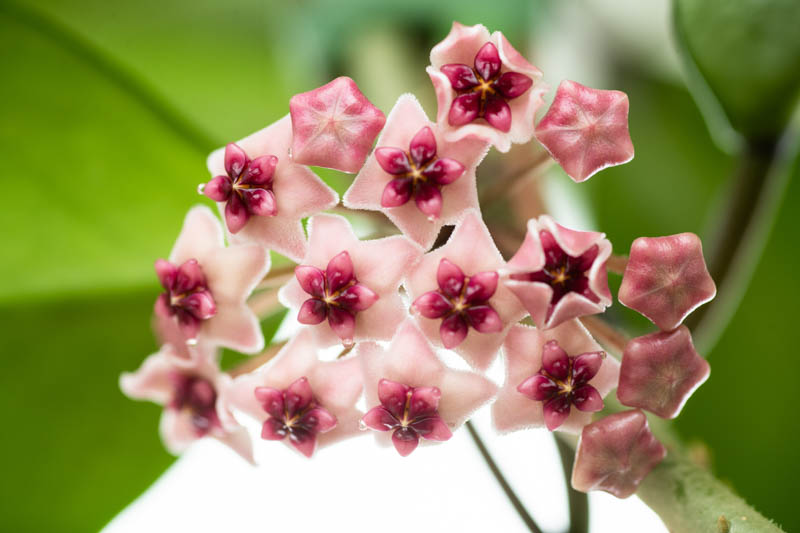Wax Plant
Hoya obovata stands out as an exceptional member of the Hoya family, celebrated for its ornamental qualities and ease of care.
Hoya obovata is distinguished by its thick, waxy leaves that are round to oval-shaped, often displaying striking silver splashes or variegation. Its robust and vining growth habit allows it to beautifully cascade from hanging baskets or climb with the right support.
Native: This species is native to parts of Asia, including Indonesia and the Himalayas, where it thrives in tropical and subtropical environments, making it adept at indoor cultivation under the right conditions. It belongs to the dogbane family (Apocynaceae), along with plumeria, periwinkle, mandevilla, or oleander.
Plant Type and Habit: As an epiphytic, evergreen perennial (growing on trees), Hoya obovata exhibits both climbing and trailing characteristics. It’s versatile in its display and capable of adding lush greenery as a potted plant or as an eye-catching hanging specimen.
Size: When grown outdoors, Hoya obovata can reach 12-20 feet (3.6 to 6 meters). However, it grows much smaller indoors.
Hoya Flower: The plant produces stunning clusters of pink, star-shaped flowers with a central, reddish corona. These blossoms are not only visually captivating but also emit a sweet fragrance, especially during the evening. Flowering typically occurs in the warmer months, from spring to fall, provided the plant is given adequate light and care.
Fruit: Like many Hoyas, obovata can produce small, pod-like fruits following successful pollination, though this is less common indoors.
Foliage: Its foliage is arguably its most striking feature, with large, glossy leaves that can feature beautiful variegation or speckling, adding to its decorative appeal.
Hardiness: It’s best suited to warm, humid environments similar to its native habitat, thriving in USDA hardiness zones 10-11 if planted outdoors.
Uses: Hoya obovata is primarily used for ornamental purposes, adorning indoor spaces with its lush foliage and striking blooms. It’s well-suited for hanging baskets, trellises, or as a tabletop plant.
Toxicity: Hoya obovata is non-toxic to pets and humans, making it a safe addition to households with animals and children.
Invasiveness: It is not considered invasive, as it’s mostly grown in controlled indoor or greenhouse environments.
Benefits: Beyond its ornamental value, Hoya obovata is believed to contribute to indoor air purification by absorbing pollutants, making it a functional and beautiful houseplant choice.

Growing and caring for Hoya obovata is a rewarding experience due to its beautiful, glossy foliage and striking blooms.
Light: Hoya obovata prefers bright, indirect light. Direct sunlight can scorch its leaves, while too little light may hinder flowering. A spot near an east or west-facing window is ideal.
Soil: Use a well-draining potting mix. A mix designed for succulents or orchids, typically including perlite, bark, and peat moss, ensures adequate drainage and aeration.
Water: Water when the top inch of soil feels dry to the touch. Hoya obovata dislikes soggy roots, so ensure good drainage. Reduce watering in the winter when growth slows.
Temperature and Humidity: Keep it in warm conditions, ideally between 60°F and 80°F (15°C and 27°C). Avoid exposure to temperatures below 50°F (10°C), as cold drafts can damage the plant. This plant enjoys high humidity, reflective of its tropical origin. Maintain humidity around it through regular misting, a pebble tray, or a humidifier, especially during dry winter months.
Fertilization: Fertilize Hoya obovata during the growing season (spring to summer) with a balanced, water-soluble fertilizer every month. Reduce feeding in fall and winter.
Pruning: Pruning is not strictly necessary but can help manage its size and shape. Prune right after flowering to encourage new growth. Avoid cutting off the flower spurs, as they rebloom from the same place.
Repotting: Repot every 2-3 years or when the plant becomes root-bound. Choose a pot only slightly larger than the current one to avoid overwatering issues.

Propagating Hoya obovata is an enjoyable and simple process that can help you expand your collection or share this beautiful plant with friends and family.
Once your Hoya obovata cutting has established roots, care for it as you would a mature plant. With proper care, it will grow into a lush, trailing plant adorned with stunning foliage and, eventually, fragrant blooms.
Hoya obovata is generally resilient, but like all plants, it may encounter pests and diseases.
Mealybugs: Look for white, cottony masses on stems and undersides of leaves. Remove with alcohol-dipped cotton swabs or apply insecticidal soap.
Scale insects: Hard, dome-shaped pests that attach firmly to stems and leaves, feeding on sap. Their presence can lead to yellowing leaves, stunted growth, and a decline in plant health.
Spider mites: Cause yellowing leaves and fine webs. Increase humidity and treat with miticide or insecticidal soap.
Root rot: Caused by overwatering and poor drainage. Ensure well-draining soil and allow the topsoil to dry out between waterings.
Yellowing Leaves: Overwatering, poor drainage, or nutrient deficiencies can cause leaves to yellow. Ensure proper watering and consider a balanced fertilizer during the growing season.
Leaf Drop: Sudden temperature changes or drafts can stress the plant, leading to leaf drop. Keep the plant in a stable environment away from cold drafts or direct heat sources.
No Blooms: Insufficient light is a common reason for the lack of flowers. Place your Hoya obovata in a location where it receives bright, indirect sunlight to encourage blooming.
Hoya obovata is generally considered a moderately fast-growing plant when provided with the right conditions, such as adequate light, warmth, and humidity. Its growth rate can also be influenced by factors like pot size, feeding schedule, and time of year, with faster growth typically observed during the spring and summer months.
Hoya obovata exhibits both trailing and climbing habits, making it a versatile plant for indoor gardening. It produces long, vining stems that can gracefully cascade over the sides of a pot or basket, making it an excellent choice for hanging displays. With the support of a trellis or other structure, it can also climb, showing off its lush, waxy foliage and beautiful blooms at eye level or higher.
While Hoya obovata does not necessarily need a trellis to thrive, providing one can encourage vertical growth and can be a great way to display the plant, especially if you’re looking to save space or create a green wall effect. Using a trellis or support also allows the plant to grow in a way that mimics its natural habit of climbing trees and other structures in its native habitat, potentially leading to better health and more vigorous growth.
| Hardiness |
10 - 11 |
|---|---|
| Plant Type | Houseplants, Climbers |
| Plant Family | Apocynaceae |
| Genus | Hoya |
| Exposure | Partial Sun |
| Season of Interest |
Spring (Early, Mid, Late) Summer (Early, Mid, Late) Fall Winter |
| Height |
12' - 20' (3.7m - 6.1m) |
| Maintenance | Low |
| Water Needs | Average |
| Soil Type | Loam, Sand |
| Soil pH | Acid, Alkaline, Neutral |
| Soil Drainage | Well-Drained |
| Characteristics | Showy, Evergreen, Fragrant |
| Garden Uses | Hanging Baskets, Patio And Containers |
| Garden Styles | Mediterranean Garden |
| Hardiness |
10 - 11 |
|---|---|
| Plant Type | Houseplants, Climbers |
| Plant Family | Apocynaceae |
| Genus | Hoya |
| Exposure | Partial Sun |
| Season of Interest |
Spring (Early, Mid, Late) Summer (Early, Mid, Late) Fall Winter |
| Height |
12' - 20' (3.7m - 6.1m) |
| Maintenance | Low |
| Water Needs | Average |
| Soil Type | Loam, Sand |
| Soil pH | Acid, Alkaline, Neutral |
| Soil Drainage | Well-Drained |
| Characteristics | Showy, Evergreen, Fragrant |
| Garden Uses | Hanging Baskets, Patio And Containers |
| Garden Styles | Mediterranean Garden |
How many Hoya obovata (Wax Plant) do I need for my garden?
| Plant | Quantity | |
|---|---|---|
| Hoya obovata (Wax Plant) | N/A | Buy Plants |
Create a membership account to save your garden designs and to view them on any device.
Becoming a contributing member of Gardenia is easy and can be done in just a few minutes. If you provide us with your name, email address and the payment of a modest $25 annual membership fee, you will become a full member, enabling you to design and save up to 25 of your garden design ideas.
Join now and start creating your dream garden!
Create a membership account to save your garden designs and to view them on any device.
Becoming a contributing member of Gardenia is easy and can be done in just a few minutes. If you provide us with your name, email address and the payment of a modest $25 annual membership fee, you will become a full member, enabling you to design and save up to 25 of your garden design ideas.
Join now and start creating your dream garden!